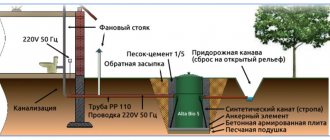Modern electrical safety requirements for a household network, whether in an apartment or a private house, provide for the installation and connection of two main types of protection. The first are circuit breakers, which protect the network from short circuits and overloads. The second element is a residual current device (RCD), which ensures the safety of human life from electric shock when touching live parts or the occurrence of leakage currents. Such protection is especially important in rooms with high humidity, that is, in the bathroom. Therefore, we will dwell in more detail on the question of how to choose an RCD for a water heater or washing machine.
Why do you need an RCD for a washing machine?
The washing machine is a powerful consumer that loads the wiring. That is why it is recommended to lay a separate power line and install automation. A TV or computer does not need a separate RCD, so why does it need to be installed on a washing machine? Working in conditions of high humidity automatically places it in a risk group, which means that special attention is required to ensure the safety of both the equipment itself and its users.
If we are talking about an expensive drying device, then one protective device will not be enough - you will need several. The maximum power consumption of the washing machine is 2.5–3 kW. This is a lot for old electrical networks - you can’t do without protection.
Installation required
The machine will provide reliable protection for electrical wiring and the device itself. The washing machine is considered one of the largest consumers of energy and creates a significant load on the wires. In addition, the device operates in a “wet” environment, which puts it in a high-risk group and requires good protection.
Based on this, experienced specialists recommend installing an RCD for a washing machine in order to maintain the functionality of the device, protect residents from electric shock, and protect property from fire.
What other protection options are there?
RCDs are installed to protect people from electric shock, but they do not protect the electrical circuit from all possible risks. To prevent equipment breakdowns, an automatic circuit breaker is switched on in series with the RCD: it is designed to protect electrical circuits from short circuits and voltage surges.
How many amperes should the automatic protective equipment be designed for? Experts note the following pattern: when installing a device at 16 A, the RCD for the washing machine placed behind it must be designed for a higher current, for example 25 A. Protection can be provided in two ways:
- install an RCD and an automatic machine;
- installing a difavtomat is the best option.
What is it for?
The main requirement when installing an RCD on washing equipment
Before we talk about why an RCD is needed, let’s define those electrical circuit protection devices that every home needs to have. People uninitiated in the basics of electricians may confuse an RCD with a circuit breaker, which is also simply called a circuit breaker. This switch is an analogue of the well-known electrical plug with a fusible rate, which burned out if the current exceeded a certain value. However, unlike a stopper, this device is reusable and once it is triggered, when the toggle switch is turned on, it is ready for use again.
Typically, this circuit breaker cuts out the current supply during short circuits, which most often occur when the integrity of the insulation in the wiring is broken and the zero and phase are shorted. Thus, when the machine is triggered, the wiring or electrical content of household appliances is protected from damage and burnout, and the living space is protected from a possible fire. Household circuit breakers for residential premises with many electrical appliances must be rated for a current of at least 16 amperes. If the apartment has an electric stove, dishwasher and washing machine, electric water heater and other appliances with high energy consumption, then a circuit breaker of 25 amperes or more may be required.
Washing machine commissioning diagram
Let's consider a typical case with a washing machine when it is connected to a regular single-phase network without grounding. Let's imagine that for one of the reasons (due to old age, wear or mechanical stress) the insulation on some phase conductor was damaged, as a result of which the phase voltage reached the metal body of the washing machine. This will not affect the operation of the washing machine in any way and its behavior will not cause any suspicion. But, if a person accidentally touches simultaneously its metal body and any conductive object that has an outlet to grounding, for example, a water faucet or a heating radiator, an electric shock may occur.
At best, a person will experience unpleasant sensations, an electric shock. At worst, cardiac arrest is possible. The currents flowing through the body will be quite small and will not reach the value at which the circuit breaker is knocked out. After all, for a fatal shock to a person, a current value of 50 mA is sufficient, and circuit breakers are designed for a current of 16 amperes or more. To avoid such cases, it is necessary to install an RCD.
It is impossible to connect an RCD without a difavtomat
The RCD is connected in series with the consumer (microwave oven, washing machine, etc.) and measures the difference in current at the input and output. Ideally, this difference should be zero. In other words, as much current came in, so much came out. For this reason, these devices are also called differential automatic machines. The name comes from the English verb Difference, which means difference, difference. If a difference is detected, then there is a leakage current.
When the magnitude of the leakage current reaches the value for which the RCD is designed to operate, it knocks out the current supply in a fraction of a second, excluding fatal injury to a person. Currents greater than 50 mA are dangerous for humans, as discussed above. Therefore, to protect life, devices with a leakage current of no more than 30 mA are used.
Let's return to the above-mentioned case with a washing machine connected to a regular single-phase network without grounding. When a person touches the body of such a machine, which is energized as a result of an insulation breakdown, the device will disconnect it from the network when it detects a leakage current passing through the person’s body.
The situation will be completely different if there is a grounding circuit. If a voltage breakdown occurs on the body of the washing machine, the current will flow through the phase-ground circuit. Therefore, the RCD immediately knocks out the power circuit, thereby ensuring safety.
How does an RCD machine work?
The well-being of household appliances in our homes often depends on worn-out electrical substations that are not designed for heavy loads. One power surge is enough to lose all electrically powered devices in one fell swoop. To save washing equipment from the vagaries of electrical networks, it is provided with a separate RCD. It consists of:
- housings;
- transformer;
- chain breaking mechanism;
- self-diagnosis mechanism;
- electromagnetic cut-off - it is available in the latest generation models.
Triggering occurs at critical loads, the machine, opening the circuit, stops the flow of electric current - people and equipment are safe.
A dangerous situation will occur, for example, if a person touches exposed wires or if water gets on him. The automation, when activated, prevents electric shock and damage to expensive equipment. The sensor can be triggered many times and, unlike fuses, does not need to be changed.
Operating principle of the machine
In the standard version, the device has a housing made of plastic material, a transformer, a relay, a release, and a self-testing mechanism. New devices are additionally equipped with electromagnetic cut-offs.
In the normal state of the network, the relay device does not work, but when there is an increased load on the wiring, the built-in device will forcibly break the circuit, de-energizing it.
A similar situation is possible due to power surges or moisture getting on exposed wires. When the protection is triggered, there is no need to change it. The main difference between an RCD for a washing machine is that it is intended for repeated use.
How to connect a washing machine to the mains?
It’s not enough to buy a washing machine, you also need to connect it correctly. When all pipes are connected, electrical work begins. Installation rules:
- Do not use the washing machine without grounding.
- Do not use extension cords. It is also not recommended to use a special extension cord with an RCD.
- In rooms with a high moisture content, sockets must be installed in a moisture-proof housing.
- Connect the washing machine through a protective device.
Connection to a three-phase network
Three-phase 380V power is used in factories and small workshops. They power machine tools, various furnaces and asynchronous motors (elevators). Installing an RCD in a three-phase network is no fundamentally different from a single-phase one. The difference lies only in the number of pins on the protective device. The three-pole RCD has 8 contacts for connecting cables. Four incoming L1, L2, L3 and N and 4 outgoing with similar markings.
Three-pole RCD
When connecting, there may be confusion in the wires. To understand the color and letter markings, it is enough to know the simple relationships from the table.
| Russian designations | European designations | ||
| Phase A | Yellow | L1 | Brown |
| Phase B | Green | L2 | Black |
| Phase C | Red | L3 | Grey |
| Neutral wire | Blue (cyan) | N | Blue (cyan) |
| Ground wire | P.E. | Green-yellow | |
Introductory three-phase RCD + separate group
The device is installed after the introductory three-pole circuit breaker. Three power supply conductors pass through it. Then they go directly to the RCD. Connection is carried out taking into account the markings. Terminal L1 at the output of the machine is connected to L1 on the protective device, L2 to L2, and so on.
After the introductory three-phase RCD, the wires go to the group circuit breakers. The zero core is connected to the common N bus. Ideally it is blue. Then the phase wires from the machines are connected to single-pole group RCDs and distributed to consumers.
Input protective device + three-phase meter
The scheme is similar to the previous one. However, in this case a three-phase electricity meter is added. It has 8 pins designed to connect 3 phases and zero. The metering device is mounted at the output of the input machine. After the meter there is a three-phase RCD. Behind it are group single-pole circuit breakers and residual current devices.
Which RCD should I install on my washing machine?
The average user wants to know which protective device to install on the washing machine. Most models consume 2 kW, and this exceeds the nominal value of 10 A. Therefore, an automatic or automatic device must operate with an electric current greater than 10 A. Choose the 16 A option.
Among the important parameters of automatic protection is leakage current. The device reacts precisely to it. If the wiring is new, take the 10 mA option. For a circuit break to occur, the difference in current between phase and neutral must be 10 mA or more. If the wiring is old, use a 30 mA RCD to avoid erroneous shutdowns.
Another nuance that is important to pay attention to when choosing an automatic machine to connect to a washing machine is the manufacturer. There are two options:
- Expensive and high quality - Legrand or ABB.
- Budget - IEK.
These are the most famous companies on the market that produce protective automation. Chinese versions are cheaper, but they will not provide the reliability that European devices provide. If you select the wrong power and electric current, the plugs will be knocked out every time you start the machine.
Why does the security system knock out?
There are often cases when, after installing a protection system, it is triggered every time you try to turn on the machine. This problem can be caused both by the characteristics of the power system and by the incorrect choice of equipment and its connection diagram.
- The low load capacity of the network causes sharp voltage surges when switching powerful equipment. The machine, changing operating modes, triggers the protection. To fix this problem, it is recommended to use a voltage stabilizer.
- The elements of the protective system are not connected correctly. The most common mistake made by users is incorrect connection of the phase and neutral wires.
- An incorrect choice of equipment was made based on power or other network parameters. For example, the rating of a difavtomat or RCD does not allow working with the machine.
- A short circuit occurs in the machine connection cable or wiring line due to damage or violation of the parameters (depletion, cracking) of the insulation. Leakage currents or short circuit mode trigger the protection.
- One or more devices of the protection complex are inoperative or operating incorrectly.
- Abnormal operating conditions occur in the engineering circuits of the washing machine. For example, excess current consumption due to heater malfunctions, errors in the electronics control unit, short circuit of the motor windings.
The most dangerous situation, which is often ignored by consumers, is the physical excess of the leakage current indicators to the RCD rating. The protection works absolutely correctly. But the owner is not happy with this.
Instead of eliminating the problem in the form of wet live parts with damaged insulation, the user installs an RCD with a higher response rating or completely removes the control unit. This should not be done under any circumstances. If the protection is triggered, you need to carefully analyze the causes and eliminate problem areas.
What kind of automatic rifle do you need?
When making a choice, pay attention to the following parameters:
- Power. Corresponds to the power of the network (single- or three-phase).
- Voltage. For a single-phase network - 220 V, for a three-phase network - 380 V.
- Denomination In household networks, it is best to install machines marked with the letter “C”. For a network with a socket, option C 16 is preferable. Sometimes type C 25 is used.
- Built-in safety switch. Which washing machine to choose? It is recommended to take A-class. There is also an AC class, but this option is not so good for powerful loads.
- Additional protective automation. Lack of protection against wire breakage - zero, will cause the RCD to fail to operate if one of the wires malfunctions.
- Differential trip current. The best option is 30 mA. There are 10 mA ones - more expensive, their use is not rational.
Differential circuit breakers designed for current protection also disconnect the load when differential currents appear. The latter can appear during a breakdown of insulation on the housing - then the currents, inflows and outflows, are not the same. When this difference appears, the device breaks the circuit and electric shock is excluded. If a person touches live parts, the electric current flowing through him will not have time to grow to a dangerous value of 0.1 A.
Parameters and characteristics of difavtomats
To decide which RCD to install for a washing machine or water heater, first familiarize yourself with the basic parameters and characteristics of the device:
- Depending on which network the difavtomat will be installed in (single-phase or three-phase), a two-pole device (for an operating voltage of 220 V) or a four-pole device (380 V) is selected. Please note that the rated operating voltage must be indicated on the device body.
- Rated current. This is the amount of current, measured in amperes, that can pass through a switching device over a long period of time. The standard range of rated currents is as follows: 6, 10, 16, 20, 32, 40, 50, 63 A.
- Time-current characteristic (“B”, “C” or “D”), this parameter expresses the dependence of the response time of the machine on the current flowing through it.
- Rated differential current. This is the amount of current leakage to which the difavtomat will react and turn off. There is also a standard range of differential current - 10, 30, 100, 300, 500 mA.
- Rated breaking capacity. This parameter represents the maximum value of short circuit current that the differential circuit breaker is capable of switching off and remaining in working condition after that.
- Temperature Range. It usually varies from – 20 degrees to + 45.
All these parameters are indicated on the device body.
There you will find a connection diagram, the nominal frequency of the power supply (50 Hz), the type of built-in RCD (electronic or electromechanical).
Also, differential circuit breakers are of three types depending on the form of current leakage to which they react:
- “A” – for alternating sinusoidal and constant pulsating current forms.
- “AC” – for alternating sinusoidal current leakage.
- “B” – for alternating sinusoidal, constant pulsating and rectified forms of current leakage.
Installing a residual current device yourself
It is not difficult to install current protection. You will need a 3x2.5 mm VVG wire - it is pulled from the switchboard. The procedure is as follows:
- Using the indicator, phase and zero are determined.
- Connect the found conductors to the RCD.
- The wires are removed from the housing and the socket is connected to the RCD.
This is the simplest connection diagram. If, in addition to the washing machine, other consumers will be connected to the network, install an additional protective device. This will ensure uninterrupted operation for all consumers.
The difavtomat is installed in the same way. Thanks to this device, your washing machine will be reliably protected from dangerous power surges that can hopelessly damage any of its components - motor, control unit, pump, etc., and you - from electric shock.
When installing the washing machine in the bathroom, the outlet must be:
- moisture-proof;
- grounded.
If washing is in progress, it is better not to take a bath: if water splashes into the socket, a short circuit may occur and an electric shock may occur. After completing the cycle, remove the plug from the socket and close the lid of the socket tightly. All laid wires are protected with plastic corrugations. The wiring is located as high as possible from the floor. The ideal solution is a separate wire for the washing machine. Its minimum cross-section is 2.5 m². The socket and protective automatic equipment must be located so that in the event of a breakdown, the equipment can be easily switched off.
Reasons for disconnecting the RCD
This may happen in the following cases:
- if the machine itself malfunctions,
- if an error is made during installation work,
- the power cord has shorted out,
- the device you selected did not meet its parameters,
- The rotor, heating element or electrical unit of the washing machine has failed.
We recommend that you take care of the safety of your family members so as not to eliminate negative consequences in the future.
Practical advice for installing difavtomats
New houses are equipped with grounded sockets and a panel with protective devices. All that remains is to select an outlet and find out which machine it is connected to. If there is an RCD there, it needs to be dismantled and a circuit breaker installed.
In old houses everything is much more complicated. There is no grounding, there is no automatic protection either. They start with installing the ground loop. Three galvanized pipes are installed near the house or in the basement. Their length is from 50 cm. The pipes are positioned so that they are the vertices of a triangle. If it doesn’t work out, you can do it on one straight line. A wire is screwed to one pipe using a bolt - it is pulled into the apartment, to the panel.
The European socket for the washing machine is connected to the automatic machine installed in the panel specifically for this purpose. The device is selected taking into account the current consumed by the equipment. It is determined based on the rated power. Power, kW, is divided by voltage, V. Then 20% is added - this will be the average current. Take the option with a current equal to the calculated value or slightly greater.
Purpose of RCD and principle of operation
The main task of the RCD is to neutralize currents when various damage occurs in electrical installations. The residual current device is the most effective protective device. Unlike fuses or circuit breakers, RCDs are capable of breaking a circuit in a split second and saving a human life.
The danger is not only the possibility of direct electric shock. Sometimes simply touching the parts of live devices and devices is enough. Therefore, protective devices must operate in a timely manner. In order to correctly solve the problem of how to choose an RCD for a home, the conditions in which it will operate must be taken into account.
The operation of protective devices uses the phenomenon of electromagnetism. In this regard, the design of the RCD includes coils with a magnetic core connected to current-carrying wires that transmit electricity to the consumer. At the same time, a magnetic flux occurs, which is the arithmetic sum of the currents flowing through these conductors. In this case, the incoming currents have a positive value, and the outgoing currents have a negative value. In the absence of leaks and short circuits, they will be equal and add up to zero. This state of the circuit indicates the serviceability of the installed equipment.
In the event of a leak, a partial reverse flow of current occurs through the grounding conductors, which leads to an imbalance. The difference in differential currents causes the excitation of magnetic flux in the core. Its value will be proportional to the difference in electric current. When a certain threshold is reached, the device is triggered and turns off the power supply to consumers.
Example of calculating a difavtomat
Initial data:
- Power consumption - 2.2 kW.
- Rated current - 10 A.
20% margin = 2 A. It turns out that for a 2.2 kW washing machine you will need a device with 12 A or more. The best option is a shutdown current of 15 A. Choose the closest value. If 12 A comes out, you cannot install a 40 A device. This is dangerous for equipment. The differential shutdown current is 30 mA, no more.
RCD connection diagram
Power (electricity) can be supplied to both the lower and upper contacts of the RCD - this statement applies to all leading manufacturers of electromechanical RCDs.
Example from the instructions for the ABB F200 RCD
I divide RCD connection diagrams into 2 types:
- This is a standard connection diagram, one RCD, one circuit breaker. Do we remember that the RCD is selected with a rated current one step higher than the machine? If we have a 25A circuit breaker on the cable line, then the RCD should be selected for 40A. Below is an example of an RCD connection diagram for an electric stove (hob).
But, if we have an apartment or a private house, where there are 20-30 cable lines, then according to the first connection scheme our panel will be huge in size, and its cost will be the same as a budget foreign car)). Therefore, manufacturers allow the installation of one RCD per group of machines. Those. one RCD for several machines
But here it is important to observe the following rule: the sum of the rated currents of the machines should not exceed the rated current of the RCD. If we have an RCD for three circuit breakers, for example a 6 A circuit breaker (lighting) + 16 A (sockets in the room) + 16 A (air conditioning) = 38 A
In this case, we can choose a 40 A RCD. But you should not “hang” more than 5 machines on the RCD, because any line has natural current leaks (cable connections, resistance of machine contacts, sockets, etc.) in the end you will get a sum of leaks that exceeds the trip current of the RCD, and it will periodically trip for no apparent reason. Or if you install a machine with a lower rated current in front of the RCD, then you can “hook” the machines to the RCD without thinking about their rated currents, but, of course, we remember that more than 5 machines should not be connected to the RCD, because the amount of natural current leakage in cables and devices will be high and close to the RCD setting. Which will lead to false positives. From this diagram it can be seen that the sum of the rated currents of the outgoing circuit breakers is 16+16+16=48 A, and our RCD is 40A, but in front of the RCD we have a 25A circuit breaker, and in this case our RCD is protected from overcurrents. This diagram was borrowed from an article where I changed automatic machines and RCDs in an apartment panel.
Connection diagram for a three-phase electric motor via an RCD
Actually, there is nothing complicated about this; for the correct operation of a three-phase RCD, we connect the neutral conductor to the neutral terminal of the RCD on the power side, and on the motor side it remains empty.
The RCD should be checked at least once a month. This is done quite simply, just press the “TEST” button, which is on any RCD.
The RCD must turn off; this should be done when the load is removed, when TVs, computers, washing machines, etc. are turned off, so as not to “tug” sensitive equipment again.”
I like ABB RCDs, which, like the ABB S200 series switches, have an indication of the on (red) or off (green) position.
Just like ABB S200 switches, there are two contacts on each pole at the top and bottom.
Thank you for your attention
Why are extension cords banned?
The power wires transmit power of more than 2 kW. Therefore, all disconnecting connections must ensure perfect contact. This is possible with European sockets that have a large area of contacting contacts. But this cannot be done without losses, and extension cords only increase them. The consequence of losses is heating. Extension cords are often plugged into regular sockets - with the help of adapters, losses increase even more. Due to constant heating, contacts burn and plugs and sockets deteriorate. As a result, a fire occurs.
Electrical problems
It is very desirable for everyone to know the basic principles of connecting a boiler to a 220V network. Not only to ensure stable operation of the equipment, but also for your own safety.
Important: be sure to connect with grounding! Please note that the power cable plug is equipped with a special grounding connector, and accordingly it can only be plugged into an outlet with grounding contacts. A good connection option is a separate line directly from the panel. Plus install a separate RCD and a circuit breaker or difavtomat on this line, as protection against emergency conditions in the electrical network
Plus, install a separate RCD and a circuit breaker or automatic circuit breaker on this line, as protection against emergency conditions in the electrical network.
Brief background information about RCDs and automatic devices
An RCD (residual current device) is installed in the distribution panel and is designed to protect against leakage currents and fire. Plus, a circuit breaker (“circuit breaker”) is installed on it; it protects the line from short circuits and overloads. Or the second option is to install a difavtomat. This is a “2 in 1” device, both an RCD and a circuit breaker at once, in a single housing. What is most convenient is that you install protection against both possible leakage currents and short circuits. Decide for yourself what to do. But at a minimum it should be an RCD for the entire bathroom. Optimally - separately for the boiler. Because ideally, an automatic or differential is matched in terms of power to a separate device and, in fact, is connected to it.
How to choose a difavtomat for a boiler
For example, for a model with a capacity of 1.6 kW (most boilers sold in Ukraine are represented by models from 30 to 100 liters of capacity and from 1.2 to 2.5 kW of power). It’s easy to select a difavtomat for the boiler yourself, without the help of an electrician (but it’s better to have a master install it). First of all, determine the value of the rated current using the formula from the school physics course: I = U/R, which in the case of our boiler will be: 1600W/220V = 7.3A. Then it is convenient to select differentials with the same or the closest increasing rated current value in an online store catalog like this one. In our situation it is 10A.
Please note that there is also an indicator for the tripping characteristics of the automatic device: “B” (instantaneous operation, suitable for equipment without inrush currents) or “C” (with a slight delay in operation for equipment with inrush currents). For the boiler, select “B”
As for the nuances of choosing technical characteristics on the part of the RCD, models with a sensitivity value to leakage currents of 30 mA will be sufficient.
In total, a selection of differentials for a 1.6 kW boiler has been formed and can be ordered. Prices start from about five thousand hryvnia - for peace of mind and understanding that your boiler is fully protected electrically. Now, having discussed the connection, let's talk about possible problems with the electrical part.
Doesn't turn on? Start with the basics: check that there is power and that the socket and plug are working properly. The connection wire may be damaged. The easiest way to check is by ringing with an indicator screwdriver or tester. If everything is in order with the network, there is a possibility that the heating element has burned out (replacement is indicated), the thermostat has stopped working (replace) or the control board is broken (replace).
Does it give you an electric shock? Firstly, a pre-installed RCD will de-energize the line when dangerous leakage currents appear and will not shock you. Don't ignore this recommendation. Secondly, in 90% of cases this happens from mechanical damage or improper installation. It was dropped, bent, and the nut was not fully tightened during installation. In normal mode there should not be an electric shock. This may be a sign of cable damage. Or a breakdown of the heating element, when cracks or chips formed somewhere in the insulating layer, exposing the core, causing 220V to go directly into the water. More often typical for old boilers and in situations where the need to install a difavtomat was ignored. Replacement of the heating element is definitely indicated. It also doesn't hurt to check the grounding.
Knocks out the RCD (difavtomat)? The following factors are possible (in order of decreasing probability): the heating element has failed (replace); water leakage or condensation in the electrical unit or on contacts; problem with the RCD (least likely).
It constantly turns off or, on the contrary, often turns on - there is a problem with the thermostat.











